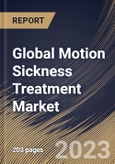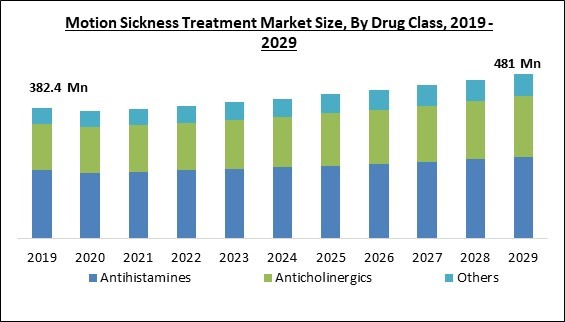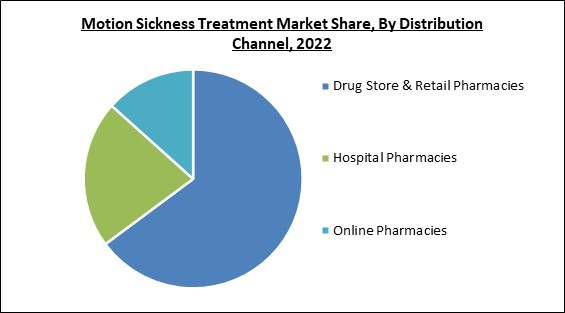The Global Motion Sickness Treatment Market size is expected to reach $481 Million by 2029, rising at a market growth of 3.2% CAGR during the forecast period.
Motion sickness is a condition that arises when the brain is unable to interpret the information received from the eyes, ears, and body. Frequent movement, whether in a vehicle, aircraft, watercraft, or a recreational attraction, can induce discomfort, perspiration, or nausea. Certain individuals experience nausea and may regurgitate. Motion sickness is a condition that occurs when traveling by car, sea, or air, causing discomfort and nausea.
When driving a vehicle, the visual senses perceive the surroundings and detect motion. The inner ears are responsible for detecting movement. The body's muscles and joints perceive a state of stillness while seated. The brain senses a lack of coherence between these messages, causing motion sickness. Various factors can induce motion sickness, including amusement park attractions and virtual reality simulations. Reading while in transit, using transportation options like boats, cars, buses, trains, and planes. Also, too much consumption of entertainment media such as movies and video games can lead to motion sickness.
Motion sickness may occur unexpectedly. Individuals may exhibit symptoms without prior warning, including perspiration caused by a sudden drop in body temperature. Dizziness, fatigue, headache, irritability, difficulty in maintaining focus. Symptoms of potential gastrointestinal distress. Fair complexion. Symptoms of respiratory distress may include rapid breathing or gasping for air.
The market research report covers the analysis of key stakeholders of the market. Key companies profiled in the report include Viatris, Inc., Teva Pharmaceutical Industries Ltd., Amneal Pharmaceuticals, Inc., Baxter International, Inc., Novartis AG, Abbott Laboratories, Sun Pharmaceutical Industries Ltd., Zydus Lifesciences Ltd., Prestige Consumer Healthcare, Inc., WellSpring Pharmaceutical Corporation (Avista Capital Partners)
Motion sickness is a condition that arises when the brain is unable to interpret the information received from the eyes, ears, and body. Frequent movement, whether in a vehicle, aircraft, watercraft, or a recreational attraction, can induce discomfort, perspiration, or nausea. Certain individuals experience nausea and may regurgitate. Motion sickness is a condition that occurs when traveling by car, sea, or air, causing discomfort and nausea.
When driving a vehicle, the visual senses perceive the surroundings and detect motion. The inner ears are responsible for detecting movement. The body's muscles and joints perceive a state of stillness while seated. The brain senses a lack of coherence between these messages, causing motion sickness. Various factors can induce motion sickness, including amusement park attractions and virtual reality simulations. Reading while in transit, using transportation options like boats, cars, buses, trains, and planes. Also, too much consumption of entertainment media such as movies and video games can lead to motion sickness.
Motion sickness may occur unexpectedly. Individuals may exhibit symptoms without prior warning, including perspiration caused by a sudden drop in body temperature. Dizziness, fatigue, headache, irritability, difficulty in maintaining focus. Symptoms of potential gastrointestinal distress. Fair complexion. Symptoms of respiratory distress may include rapid breathing or gasping for air.
COVID-19 Impact Analysis
During the COVID-19 pandemic, the number of tours and journeys throughout the world declined, which led to a subsequent drop in sales of motion sickness medication. As a result, the market for motion sickness therapy was significantly damaged. In addition, the pandemic was responsible for the shutdown or suspension of production operations in most industrial units around the world. This had an effect, to some degree, on the production of motion sickness treatments. The healthcare industry has experienced a disruption in workflows due to the COVID-19 pandemic.Market Growth Factors
Rising Tourism Industry
The travel and tourism industry are increasing due to the increasing affordability of air travel, enhanced accessibility to remote and picturesque destinations, and a surge in disposable income. The travel and tourism sector has been strengthened by the substantial development of transportation facilities and infrastructure. There is a growing demand among millennial travelers for distinctive and exclusive experiences and also ecotourism is a growing trend in the current scenario. National and international tourism is increasing in almost all parts of the world, and individuals use various types of transportation to reach their destinations, like airplanes, cars, and ships. However, these modes of transportation can cause many travelers’ motion sickness to kick in, which may require treatment and thereby propel the market growth.Growing Pharma Sector to Provide Enhanced Motion Sickness Medications
The pharmaceutical industry has experienced significant changes due to the introduction of innovative technologies and streamlined manufacturing processes that are both cost-effective and efficient. Furthermore, the rise in investment flow within this sector has positively impacted sector growth. Integrating robotic technology and AI leads to decreased manufacturing floor downtime and minimizes product waste. The development of the pharma sector and its technological advancement is expected to provide more efficient and cost-effective medications for motion sickness and thereby increase their adoption, driving the market growth for motion sickness treatment.Market Restraining Factors
Associated Side Effects of Motion Sickness Medication
H1-antihistamines in certain professions, such as astronauts, are limited due to side effects that can affect cognitive function, memory, psychomotor performance, drowsiness, fatigue, and dizziness. Additional documented negative outcomes comprise dystonia, dyskinesia, restlessness, disorientation, delusions, and potential harm to the heart. Furthermore, the anticholinergic activity of first-generation antihistamines may result in adverse effects, including but not limited to dry mouth, blurred vision, dilated pupils, and urinary retention. Hence, with the side effects of antihistamines and anticholinergics two most prominent drug classes for the treatment of motion sickness can decrease the adoption of these treatment options and, thereby, hamper the market growth of motion sickness treatment.Drug Class Outlook
Based on drug class, the motion sickness treatment market is segmented into antihistamines, anticholinergics and others. The antihistamines segment dominated the motion sickness treatment market with maximum revenue share in 2022. This is because antihistamines are a cost-effective and readily available solution for reducing motion sickness. This is due to a rise in the prevalence of motion sickness among travelers. Furthermore, the segment's growth is being propelled by the presence of major players who provide antihistamine medications to prevent and treat motion sickness.Route of Administration Outlook
On the basis of route of administration, the motion sickness treatment market is divided into oral and others. The others segment procured a substantial revenue share in the motion sickness treatment market in 2022. This is due to the rise in the usage of transdermal patches for motion sickness treatment and prevention, which is the reason behind this trend. In addition, these transdermal patches provide benefits such as user-friendliness, controlled release mechanism, and extended efficacy in comparison to traditional medications.Distribution Channel Outlook
By distribution channel, the motion sickness treatment market is classified into drug store & retail pharmacies, online pharmacies and hospital pharmacies. The drug store & retail pharmacies segment witnessed the largest revenue share in the motion sickness treatment market in 2022. This is because pharmacies and drug stores have been the traditional means of distributing motion sickness medication to consumers. These establishments offer these products at discounted prices. Drug stores and retail pharmacies are the preferred choice for purchasing motion sickness medications among most of the population.Regional Outlook
Region-wise, the motion sickness treatment market is analyzed across North America, Europe, Asia Pacific, and LAMEA. The North America region registered the highest revenue share in the motion sickness treatment market in 2022. North America's dominant position in the healthcare industry can be attributed to its robust healthcare infrastructure and government backing for high-quality healthcare. As a result, North America has a significant number of prominent market players who provide top-notch motion sickness medications.The market research report covers the analysis of key stakeholders of the market. Key companies profiled in the report include Viatris, Inc., Teva Pharmaceutical Industries Ltd., Amneal Pharmaceuticals, Inc., Baxter International, Inc., Novartis AG, Abbott Laboratories, Sun Pharmaceutical Industries Ltd., Zydus Lifesciences Ltd., Prestige Consumer Healthcare, Inc., WellSpring Pharmaceutical Corporation (Avista Capital Partners)
Scope of the Study
By Drug Class
- Antihistamines
- Anticholinergics
- Others
By Route of Administration
- Oral
- Others
By Distribution Channel
- Drug Store & Retail Pharmacies
- Hospital Pharmacies
- Online Pharmacies
By Geography
- North America
- US
- Canada
- Mexico
- Rest of North America
- Europe
- Germany
- UK
- France
- Russia
- Spain
- Italy
- Rest of Europe
- Asia Pacific
- China
- Japan
- India
- South Korea
- Singapore
- Malaysia
- Rest of Asia Pacific
- LAMEA
- Brazil
- Argentina
- UAE
- Saudi Arabia
- South Africa
- Nigeria
- Rest of LAMEA
Key Market Players
List of Companies Profiled in the Report:
- Viatris, Inc.
- Teva Pharmaceutical Industries Ltd.
- Amneal Pharmaceuticals, Inc.
- Baxter International, Inc.
- Novartis AG
- Abbott Laboratories
- Sun Pharmaceutical Industries Ltd.
- Zydus Lifesciences Ltd.
- Prestige Consumer Healthcare, Inc.
- WellSpring Pharmaceutical Corporation (Avista Capital Partners)
Unique Offerings
- Exhaustive coverage
- The highest number of Market tables and figures
- Subscription-based model available
- Guaranteed best price
- Assured post sales research support with 10% customization free
Table of Contents
Chapter 1. Market Scope & Methodology
Chapter 2. Market Overview
Chapter 3. Global Motion Sickness Treatment Market by Drug Class
Chapter 4. Global Motion Sickness Treatment Market by Route of Administration
Chapter 5. Global Motion Sickness Treatment Market by Distribution Channel
Chapter 6. Global Motion Sickness Treatment Market by Region
Chapter 7. Company Profiles
Companies Mentioned
- Viatris, Inc.
- Teva Pharmaceutical Industries Ltd.
- Amneal Pharmaceuticals, Inc.
- Baxter International, Inc.
- Novartis AG
- Abbott Laboratories
- Sun Pharmaceutical Industries Ltd.
- Zydus Lifesciences Ltd.
- Prestige Consumer Healthcare, Inc.
- WellSpring Pharmaceutical Corporation (Avista Capital Partners)
Methodology

LOADING...










